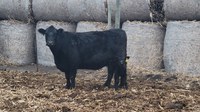Get More Nutrients With Less Feed
(Click the image below to view a high-resolution image that can be downloaded)
When commodity feed prices become high, consider options for getting more out of your livestock feed.
“Added processing of grain, using totally mixed rations, feed additives and other management changes will improve the digestion efficiency of feed,” says Karl Hoppe, Extension livestock systems specialist at North Dakota State University’s Carrington Research Extension Center. “Because feed prices have drastically increased in the past year, using other methods to get more nutrients out of the feed is now cost effective.”
For example, processing (rolling, cracking, grinding) corn grain will improve digestibility 5% to 7%. When corn was priced at $3.25 per bushel, the added value from processing was about $7 per ton. With corn prices at $7 per bushel, the added value is about $15 per ton.
Processing costs can vary. On-farm processing may cost $5/ton while commercial processing costs $10 or more per ton plus freight.
Grains with tight husks respond very favorably to processing. Barley, for example, needs to be processed to improve utilization. While cows will grind barley with their teeth, only about half of the kernels consumed are processed.
Barley ferments rapidly in the cows’ rumen and processing needs to be matched with the correct ration mix. A ration with a high percentage of forage can incorporate finely ground feed without negative digestive side effects.
High-percentage grain diets should not be overprocessed. For barley, every husk needs to be fractured. However, overprocessing (grinding too finely) may lead to acidosis. The risk of this occurring is decreased with high forage diets and increased with concentrate-based diets.
Here are some other ways to get more out of livestock feed:
- Using a totally mixed ration (TMR) can improve digestion efficiencies just by maintaining a uniformly mixed feed. This improves rumen microbial digestion by having consistent, uniform feeds to ferment. TMRs also reduce sorting at the feed bunk, allow for correct ration formulation, aid in correct ration delivery weights (when scales are used) and allow for mixing of numerous feeds and feed additives. TMRs are used with ground hay or other forages. Grinding forage allows for mixing with other feeds and reduces feed waste.
- The feed additive ionophores (monensin and lasolocid) improve feed digestion by changing the microbial populations in the rumen. Feed efficiency can be improved 7% to 10% when ionophores are added to the ration. Ionophores also can act to reduce the incidence of coccidiosis. Other feed additives can improve rumen fermentation by stimulating microbial growth. Yeast derivates and cultures are referred to as prebiotics and function to supply nutrition and stimulate bacteria in the gut. Probiotics are live or dead bacterial supplements that are designed to colonize the digestive tract. Although research results are inconsistent, some studies have shown increased feed efficiency and performance when these products are used on a consistent basis. These products are available in powders, pastes and boluses.
- Using feed bunks or some type of barrier is a good idea to reduce feed waste. Feeding cattle on pasture without bunks will lead to feed waste. While the cattle may appear to have eaten the feed, 10% to 20% of the feed may be trampled or lost into the soil. In addition, the lost feed often is the finer, higher quality feed.
- Adequate water is needed for better microbial digestion. As the rate of liquid dilution increases, the better the feed utilization. While you can’t make a cow drink, provide adequate good-quality water and adequate drinking space so cows will consume enough water. Also, if the ration is very dusty, adding a high-moisture feed, liquid supplement or clean water will reduce the dust and wind-blown feed losses and increase palatability of the ration.
- Avoid feed inventory losses. While this doesn’t increase digestion directly, it does affect efficiency by reducing feed losses.
- Feeds containing high fiber content (forages and crop residues) can be ammoniated with anhydrous ammonia or treated with calcium oxide or calcium hydroxide to increase energy content. These are very caustic chemicals and caution is advised. Feed such as cattails, straw and corn stover can be ammoniated. Ammoniation works best at 14% 18% moisture, but such feed may be difficult to find during a drought. Lower moisture content feeds will take longer (six to 10 weeks) for the chemical reaction to occur. Calcium oxide or hydroxide treatment requires mixing with water to create a final product containing 50% dry matter. Both of these treatments require a chemical reaction and adequate time before feeding. Producers should consider the market value of feedstuffs and treatment costs when weighing the potential increases in feed efficiency.
- A balanced ration will improve digestion efficiency. Adequate protein and the right type of protein will affect microbial digestion. Adequate vitamins and mineral are needed for the animal to use the energy and proteins in feed efficiently. Proper sampling and laboratory analysis of feeds and forages becomes even more important when facing high feed prices and drought.
- Use a qualified nutritionist to balance rations and use the appropriate feeds in the rations mix. Certain blends of feeds complement each other and improve digestibility.
NDSU Agriculture Communication - May 12, 2021
Source: Karl Hoppe, 701-652-2951, karl.hoppe@ndsu.edu
Editor: Ellen Crawford, 701-231-5391, ellen.crawford@ndsu.edu


